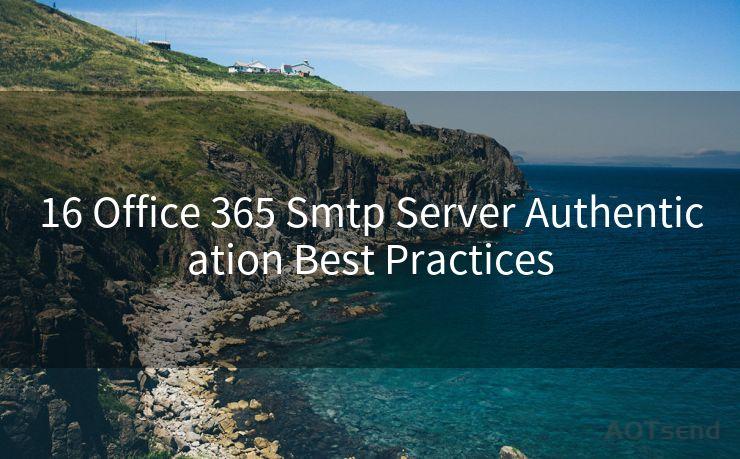16 Office 365 Smtp Server Authentication Best Practices




1. Introduction
When it comes to email communication, Office 365 stands as a popular choice for businesses due to its reliability and scalability. However, to ensure secure and efficient email delivery, it's crucial to follow SMTP server authentication best practices. In this article, we'll explore the top 16 best practices for Office 365 SMTP server authentication.

2. Understanding SMTP Authentication
SMTP (Simple Mail Transfer Protocol) authentication is a process that verifies the identity of the sender when sending emails. It's a security measure to prevent email spoofing and ensure that only authorized users can send emails from a specific domain.
3. Enable Multi-Factor Authentication (MFA)
One of the first steps in securing your Office 365 SMTP server is to enable Multi-Factor Authentication (MFA). This adds an extra layer of security by requiring additional verification methods, such as a code sent to your phone, beyond just a password.
4. Use Strong Passwords
Enforcing strong password policies is essential. Make sure passwords are complex, unique, and changed regularly. Avoid using common words or phrases that can be easily guessed.
5. Implement SPF Records
Sender Policy Framework (SPF) records help verify the legitimacy of email senders by specifying which servers are authorized to send emails from a particular domain. Implementing SPF records reduces the chances of email spoofing.
6. Configure DKIM Signing
DomainKeys Identified Mail (DKIM) is an email authentication technique that allows the receiver to verify that an email was indeed sent and authorized by the owner of the sending domain. Configuring DKIM signing enhances email security.
7. Enable DMARC Policy
Domain-based Message Authentication, Reporting, and Conformance (DMARC) is a technical specification that builds on the existing SPF and DKIM protocols. Enabling DMARC helps protect against email spoofing and phishing attacks.
8. Restrict Access to SMTP Settings
Limit access to SMTP settings to prevent unauthorized changes. Only allow trusted administrators to modify these settings.
9. Monitor and Review Logs Regularly
🔔🔔🔔
【AOTsend Email API】:AOTsend is a Managed Email Service for sending transactional emails. Support Email Types: reminders, authentication, confirmations, notifications, verification codes, invoices, password resets, account activations, billing statements, two-factor authentication (2FA), and one-time passwords (OTP) emails, etc. $0.28 per 1000 Emails. 99% Delivery, 98% Inbox Rate.
You might be interested in:
Why did we start the AOTsend project, Brand Story?
What is a Managed Email API, How it Works?
Best 25+ Email Marketing Platforms (Authority,Keywords&Traffic Comparison)
Best 24+ Email Marketing Service (Price, Pros&Cons Comparison)
Email APIs vs SMTP: How they Works, Any Difference?
Regularly monitoring and reviewing SMTP server logs can help identify any suspicious activity or unauthorized access attempts.
10. Use TLS Encryption
Ensure that your SMTP server supports Transport Layer Security (TLS) encryption to protect email data during transmission.
11. Update and Patch Regularly
Keep your Office 365 and SMTP server up to date with the latest security patches and updates to protect against known vulnerabilities.
12. Implement Firewall and IPS/IDS
Deploy a firewall and Intrusion Prevention System/Intrusion Detection System (IPS/IDS) to monitor and block malicious traffic targeting your SMTP server.
13. Avoid Using Unencrypted Connections
Never use unencrypted connections for SMTP authentication as they are prone to eavesdropping and man-in-the-middle attacks.
14. Implement Email Filtering
Use email filtering solutions to block spam and malicious emails before they reach your SMTP server.
15. Train Employees on Security Best Practices
Educate your employees on email security best practices, including recognizing phishing emails and avoiding clicking on suspicious links or attachments.
16. Have a Response Plan
Prepare a response plan in case of a security incident. Know how to quickly isolate the problem, notify relevant parties, and restore services.
By following these 16 best practices for Office 365 SMTP server authentication, you can significantly enhance the security of your email communications and protect your organization from potential threats. Remember, security is an ongoing process, and it's essential to stay vigilant and adapt to evolving threats.




Scan the QR code to access on your mobile device.
Copyright notice: This article is published by AotSend. Reproduction requires attribution.
Article Link:https://www.mailwot.com/p4714.html



